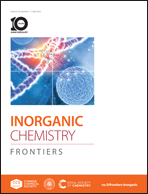Regulating the trap distribution of ZnGa2O4:Cr3+ by Li+/Ga3+ doping for upconversion-like trap energy transfer NIR persistent luminescence†
Abstract
ZnGa2O4:Cr3+ persistent luminescent phosphors (PLPs) have been widely applied in bioimaging and photonics due to their ultra-long near-infrared (NIR) afterglow. However, UV and visible excitation currently in use have shallow penetration depths or harmful effects on organisms, which limit long-term bioimaging. Therefore, developing NIR PLPs excited by NIR light is urgent for bioimaging. Here, Zn1−x(Li/Ga)xGa2O4:Cr3+ (x = 0–1) NIR PLPs were synthesized. All the newly introduced Ga3+ ions occupy the tetrahedral sites. However, with increasing Li+/Ga3+ content, Li+ ions first occupy the tetrahedral position, then partially enter octahedral sites, and completely occupy the octahedral sites at x = 1. The incorporation of Li+/Ga3+ contributes to weakened crystal field strength, which leads to a deeper trap depth and a wider trap energy level. Complete replacement of Zn2+ with Li+/Ga3+ ions leads to the splitting of the trap energy level into two-divided ones, which reduces the electron transfer between deep/shallow traps and makes the deep trap energy level come close to the 2E energy level of Cr3+. Therefore, an enhanced NIR afterglow excited by the low-energy NIR light is found for the Li+/Ga3+ doped sample. This work provides a new category for NIR-absorptive-NIR-emissive PLPs and proposes a new phosphor for long-term bioimaging.

- This article is part of the themed collection: 2023 Inorganic Chemistry Frontiers HOT articles


 Please wait while we load your content...
Please wait while we load your content...